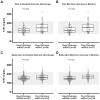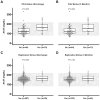Association of A1AT With Poor Functional Outcome in Patients With Acute Ischemic Stroke
- PMID: 40247624
- PMCID: PMC12184608
- DOI: 10.1161/JAHA.124.036727
Association of A1AT With Poor Functional Outcome in Patients With Acute Ischemic Stroke
Abstract
Background: This study aimed to investigate whether A1AT (α-1 antitrypsin) bloodstream levels, measured acutely after ischemic stroke, can predict the outcome of patients with stroke.
Methods and results: Two cohorts of patients with stroke were studied independently and retrospectively: a pilot cohort of 59 patients and a larger replicative study with 527 patients. Blood samples were drawn at hospital admission (<6 hours after stroke onset) before any treatment was given. A1AT levels were analyzed. Patients were followed after the event, and functional outcomes were evaluated at in-hospital (discharge) and midterm (third month) follow-up according to the modified Rankin Scale (considering modified Rankin Scale score >2 a poor outcome). Association studies between A1AT levels and functional outcomes were conducted. We also evaluated the added value of A1AT as a prognostic biomarker over the clinical model (sex, age, premorbid modified Rankin Scale and National Institutes of Health Stroke Scale scores) with the likelihood ratio test. In both studies, the levels of A1AT were higher in patients who had worse outcomes, were older, and had higher National Institutes of Health Stroke Scale scores at admission. In the pilot study, higher levels of A1AT were also associated with death at discharge and at 3 months after stroke (P=0.035 and P=0.023, respectively). The addition of A1AT to the clinical model did not show enough evidence of increasing the fit of the model to the data in either cohort.
Conclusions: Based on our data, we cannot claim that A1AT is an independent biomarker of ischemic stroke. Nevertheless, A1AT is potentially involved in stroke outcomes and might be explored as a potential therapeutic target.
Keywords: A1AT; biomarker; outcome; stroke.
Conflict of interest statement
None.
Figures


Similar articles
-
Blood-Based Frailty Index in Patients with Acute Ischemic Stroke Undergoing Endovascular Treatment.Cerebrovasc Dis. 2025;54(4):518-526. doi: 10.1159/000540605. Epub 2024 Jul 27. Cerebrovasc Dis. 2025. PMID: 39068907
-
Sex-Based Analysis of Treatment, Time Metrics, and Outcomes in Acute Ischemic Stroke Patients Treated in the Netherlands.Cerebrovasc Dis. 2025;54(3):356-362. doi: 10.1159/000540224. Epub 2024 Jul 22. Cerebrovasc Dis. 2025. PMID: 38972310 Free PMC article.
-
Signs and symptoms to determine if a patient presenting in primary care or hospital outpatient settings has COVID-19.Cochrane Database Syst Rev. 2022 May 20;5(5):CD013665. doi: 10.1002/14651858.CD013665.pub3. Cochrane Database Syst Rev. 2022. PMID: 35593186 Free PMC article.
-
Tryptophan metabolites as biomarkers to predict the severity and prognosis of acute ischemic stroke patients.J Stroke Cerebrovasc Dis. 2025 Aug;34(8):108382. doi: 10.1016/j.jstrokecerebrovasdis.2025.108382. Epub 2025 Jun 17. J Stroke Cerebrovasc Dis. 2025. PMID: 40553901
-
Systemic pharmacological treatments for chronic plaque psoriasis: a network meta-analysis.Cochrane Database Syst Rev. 2021 Apr 19;4(4):CD011535. doi: 10.1002/14651858.CD011535.pub4. Cochrane Database Syst Rev. 2021. Update in: Cochrane Database Syst Rev. 2022 May 23;5:CD011535. doi: 10.1002/14651858.CD011535.pub5. PMID: 33871055 Free PMC article. Updated.
Cited by
-
uPAR and cFn as candidate protein biomarkers for identifying low response to rtPA in acute ischemic stroke.Eur J Med Res. 2025 Jul 24;30(1):662. doi: 10.1186/s40001-025-02772-4. Eur J Med Res. 2025. PMID: 40707981 Free PMC article.
References
-
- Ramiro L. Deciphering Ischemic Stroke: Multi‐Omic Techniques to Discover New Biomarkers and Therapeutic Targets. Thesis. Bellaterra: Universitat Autònoma de Barcelona; 2021.
MeSH terms
Substances
LinkOut - more resources
Full Text Sources
Medical
Research Materials

